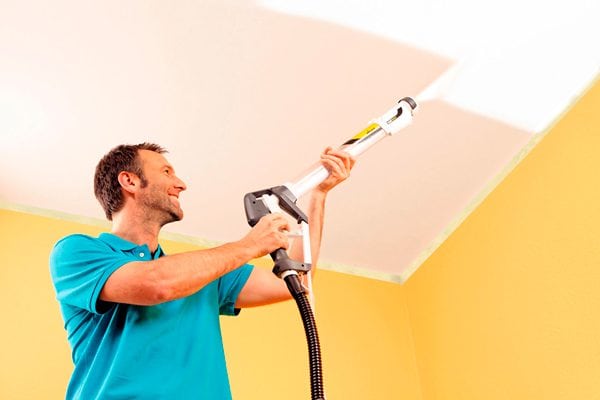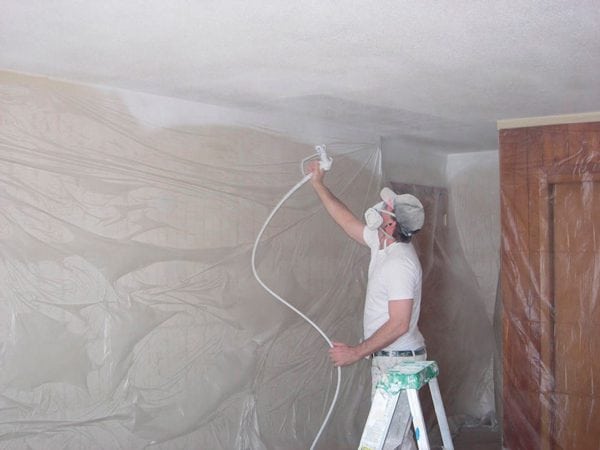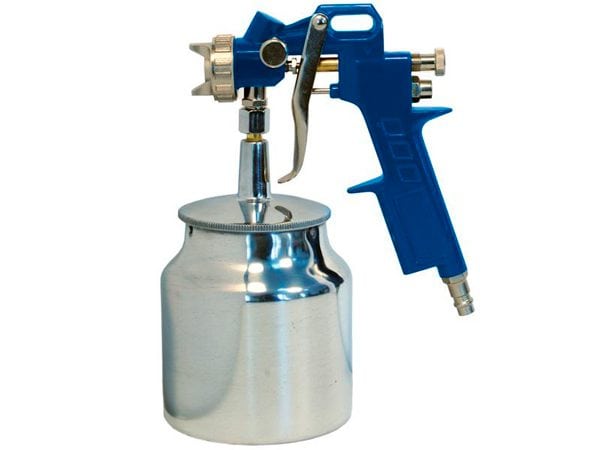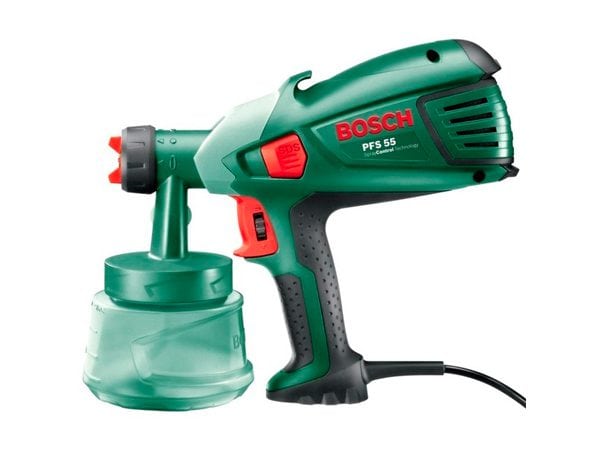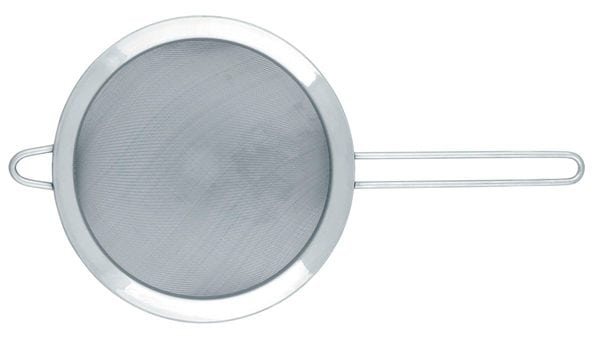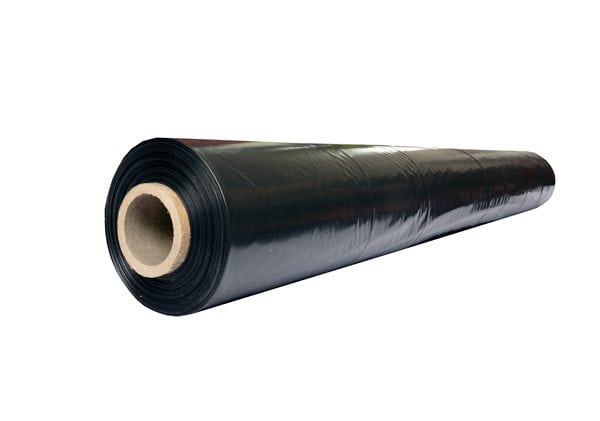Despite the various technologies for decorating rooms, lime whitewashing does not lose popularity as a simple and cheap way to give an attractive appearance to a ceiling or walls. The disadvantage of this repair method is that it is not always possible to whiten evenly: stains from a brush or roller remain on the surface. But professional craftsmen have found a solution to this problem and recommend using a spray gun for whitewashing.
- Device advantages
- Model selection
- Hand held
- Pneumatic
- Electric
- How does a spray gun work?
- How to work with the tool
- Training
- Lime application
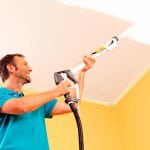
Device advantages
Why use a whitening sprayer? The fact is that the lime solution is quite caustic and fluid. If it gets on hands, it can cause burns, and if it is applied unevenly to the surface during drying, form drips and stains. Using a spray gun, you can achieve the following:
- Lime will lie in an even layer.
- It will be possible to paint even the most inaccessible places (especially often problems with smooth application of the solution arise when painting corners).
- No need to use a stepladder or goats to whitewash the ceiling or the top of the walls.
In addition, when whitewashing with your own hands, time is significantly saved - the spray gun allows you to quickly paint large areas, applying whitewashing in an even layer and making spraying minimal. All the advantages become most noticeable when the ceiling is whitewashed with a spray gun, because it is this part of the room that is always painted the worst, and often it is necessary to re-apply a layer of lime to hide the stains. Using a spray gun allows you to whiten smoothly, quickly, and even a novice master can get an excellent result.
to contents ↑Model selection
Which sprayer do you need? There are no special requirements, anyone will do. But the spray gun is not purchased for single use. Therefore, it is worth considering the characteristics of all models and their applications. Spray guns are manual, pneumatic and electric.
Hand held
The most popular type of spray guns. It is chosen by consumers who need to quickly make repairs with their own hands or paint small objects. The advantages of manual models include the following:
- The simplicity of the device. It is easy to disassemble and assemble the spray gun and, if necessary, to replace failed parts.
- Convenience in management. Even a beginner can regulate the supply of dye.
- Universality. Suitable for almost all fine dyes.
- Low cost.
A hand-held spray gun for whitewashing and painting is convenient when a very large amount of work is not required (for example, when whitewash the ceiling or walls in a residential building or utility room). A small minus of the equipment is the need to manually maintain a certain pressure in the tank, otherwise the speed of the paint stream begins to fall.
to contents ↑Pneumatic
Pneumatic whitewashing equipment is chosen by professionals when a large amount of work is required. It differs from manual operation in principle: a constant pressure of the ink jet is supported by the compressor. Thanks to the high pressure, the whitewashed ceiling looks almost flawless.
But pneumatic devices are expensive.For home repairs with your own hands, when the tool will not be used very often, it is impractical to purchase them.
to contents ↑Electric
If for some reason it is impractical to get a pneumatic spray gun, and you want to make an ideal repair, then it is recommended to pay attention to the electric spray gun. In it, the pressure of the ink jet is provided by an electric motor. According to the reviews of home craftsmen, the result of working with an electric painting gun is almost as good as a pneumatic tool in quality.
to contents ↑How does a spray gun work?
The principle of operation of any model is as follows:
- Pressure is pumped into the paint container through a special hose (compressor, pressing a special lever or electric motor).
- Pressure helps to supply dye to the suction hose.
- from the hose, the solution passes through the fishing rod and is sprayed through the spray nozzle.
On some models, it is possible to adjust the size of the nozzle to obtain the required spray radius.
to contents ↑How to work with the tool
The whole process can be divided into two stages: the preparation of the mortar and equipment and the actual application of lime on the walls or ceiling.
Training
The preparatory work includes the following:
- Checking the health of the tool. Even if the master keeps his atomizer in order, it is worthwhile to additionally check the operation of all nodes by filling the device with a small amount of water. After checking the health, it is recommended to adjust the size of the nozzles, making them minimal. This is necessary for economical and uniform application of the dye.
- Strain the solution. If this is not done, then the nozzle holes on the spray gun will quickly become clogged, and the tool will become poor quality. You can strain the lime through a fine sieve or through a doubled gauze.
Despite the fact that using a spray gun it is possible to avoid burns with a lime mortar, the jet tearing out of the nozzle not only paints the surface, but also forms a fine suspension in the air. Microscopic particles can settle on the skin, causing dryness and irritation of the skin, in the eyes or respiratory tract, and settle on furniture. Therefore, it is recommended to work with gloves, a respirator, covering all skin areas with clothing.
It is necessary to lay a plastic film on the floor and furniture. After completing the preparatory phase, you can apply lime on the walls.
to contents ↑Lime application
Having prepared everything you need and pouring the prepared solution into the spray bottle, you should not immediately direct the jet at the ceiling or wall, it is better to try it on a piece of unnecessary cardboard: air may be in the nozzle, and instead of a jet of paint, uneven “spitting” will appear. Compared to paints and varnishes, wet lime is easily removed with a wet rag, but still professionals recommend adjusting the tool to an unnecessary piece of material. After adjusting the device, you can begin to work, observing the following rules:
- When painting the walls, keep the spray gun perpendicular to the surface, and when painting the ceiling, the angle should be 60-70 °. It is impossible to “shoot” a stream directly at the ceiling - the solution is liquid, and the stream will slightly smear the colored areas located on the periphery.
- You need to drive the tool smoothly, without lingering in one place.
- It is recommended to start painting from the corners, painting them with spiral or longitudinal-transverse movements.
- The first coat is applied as finely as possible. It is not scary if through it the darkening material of the wall is a little peeked in places - after applying the second layer everything will disappear and the surface will turn white as a sheet of paper.
It did not work out the first time, and the layer turned out with errors? Then it’s worth remembering how many times you had to paint over the stains left by the brush. A little experience, and everything will work out. The third layer is likely to provide the perfect work result.
If a paint spray gun is used for whitewashing lime, then even a novice master can get an excellent result.

